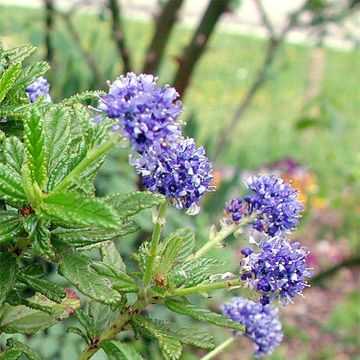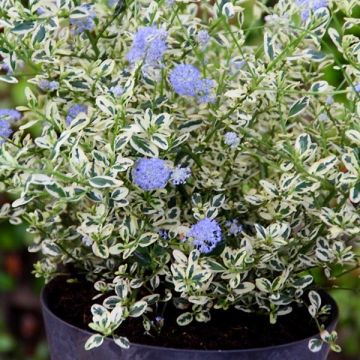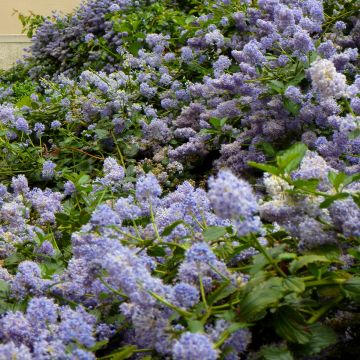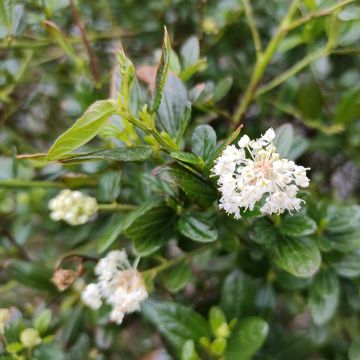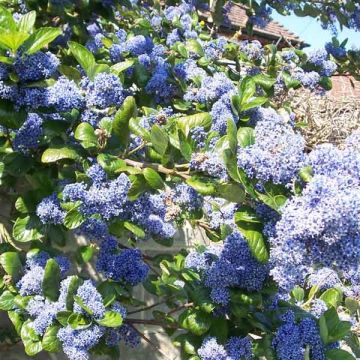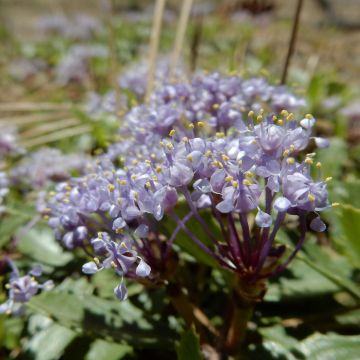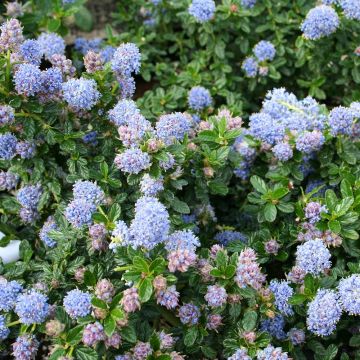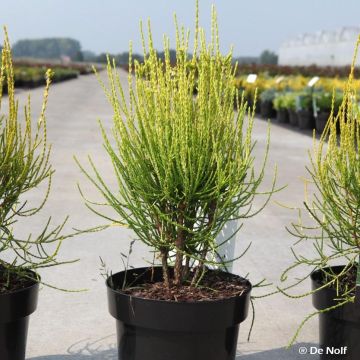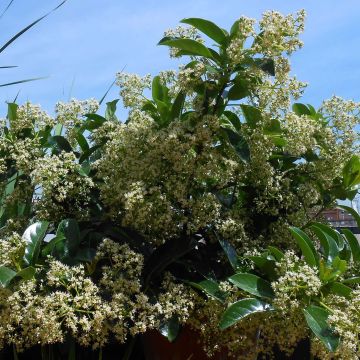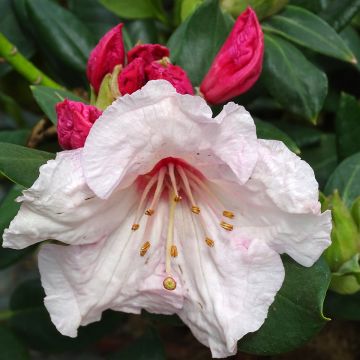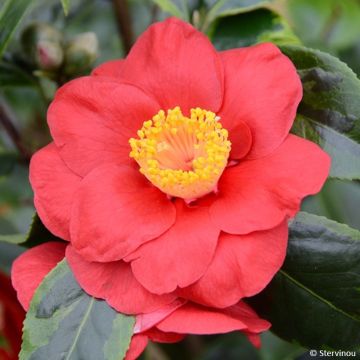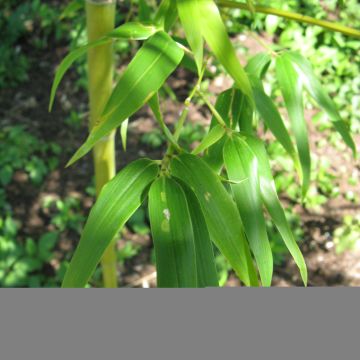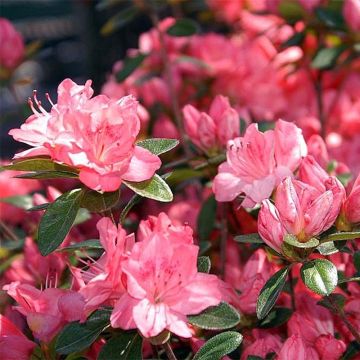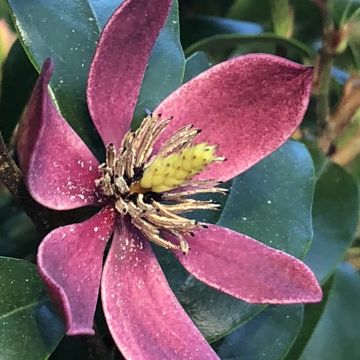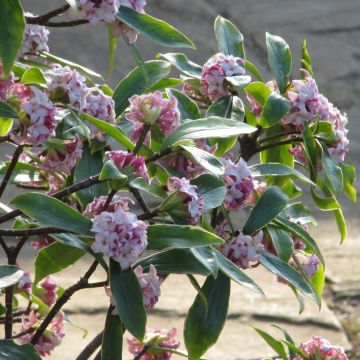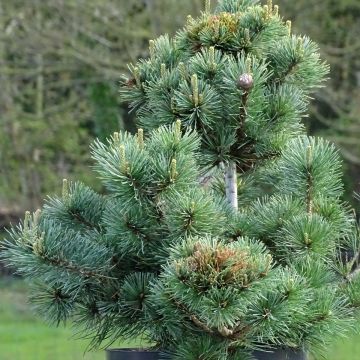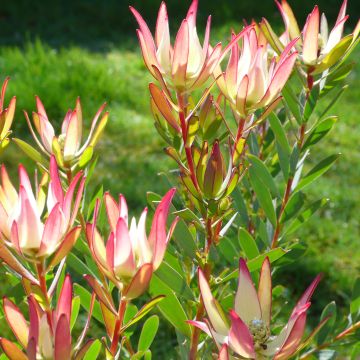

Ceanothus thyrsiflorus El Dorado
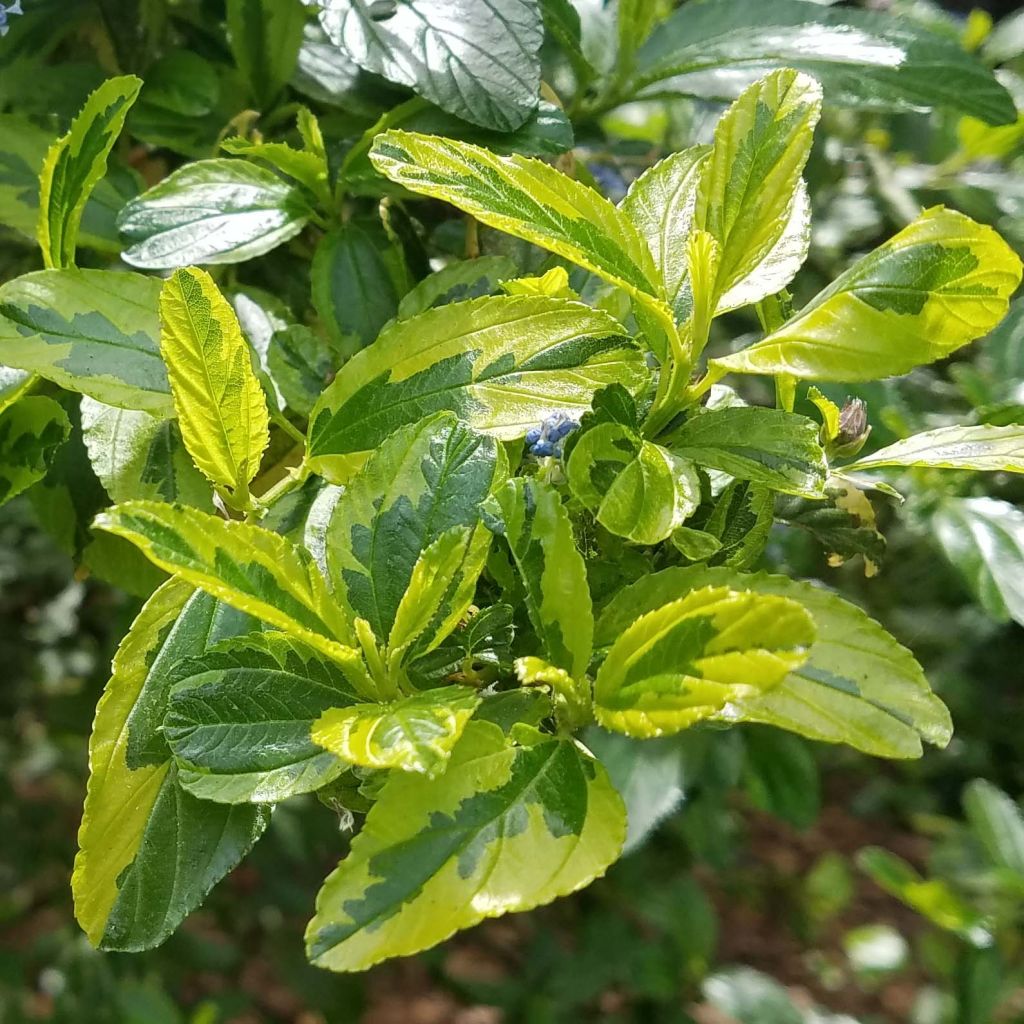

Ceanothus thyrsiflorus El Dorado
Ceanothus thyrsiflorus El Dorado
Ceanothus thyrsiflorus El Dorado
California Lilac, Carmel Ceanothus
This item cannot be shipped to the selected country
Delivery charge from €5.90
More information
Schedule delivery date,
and select date in basket
This plant carries a 24 months recovery warranty
More information
We guarantee the quality of our plants for a full growing cycle, and will replace at our expense any plant that fails to recover under normal climatic and planting conditions.
From €5.90 for pickup delivery and €6.90 for home delivery
Express home delivery from €8.90.

Does this plant fit my garden?
Set up your Plantfit profile →
Description
Ceanothus thyrsiflorus 'El Dorado' is an original variety of California lilac, which stands out for its variegated yellow-green foliage. This evergreen bush of medium stature remains ornamental all year round because of its beautiful foliage. Its spring flowering in small clusters of deep blue, contrasts wonderfully with its bright foliage. With its upright and bushy habit, it will be perfect for brightening up a dark wall, which will in turn protect it from cold winds in winter. It tolerates both sun and summer drought, and remains quite sensitive to cold suffering as soon as the temperature drops below -7°C(-19.5°F).
Ceanothus 'El Dorado', sometimes known as 'Perado', is a horticultural variety obtained in the UK at the Pershore College of Horticulture in 1996. The Ceanothus thyrsiflorus is a botanical species endemic to California and the state of Oregon. Ceanothus belong to the family Rhamnaceae, they are relatives of our alder buckthorn (Frangula alnus), growing in scrub vegetation and relying on rainwater, once established.
'El Dorado' is an upright bush, supported by flexible branches that slightly arch towards the ground; it is a dense and regular shrub that can reach 3m (10ft) in height, with a spread of 2.50m (8ft). Its blue flower buds appear in April-May, depending on the climate grouped in small dense panicles at the tips of last year's branches. They blossom into light blue flowers in small clusters. This remarkably fragrant flowering is rich in nectar and is followed by the formation of seeds which are explosively released. The evergreen foliage is composed of small alternate, elongated and finely toothed leaves, a shiny dark green colour edged with lemon yellow and measuring 1 to 2cm (0.4 to 0.8in) long. Its average lifespan is 15 to 20 years, and it prefers a maritime climate.
The Ceanothus 'El Dorado' is a beautiful specimen to plant individually on a terrace, not far from the front door or against a low wall. It can also be mixed with a mass of easy-to-grow bushes which will precede or complement its magnificent flowering while contrasting with its astonishing foliage. It can be placed in a flower bed, an informal hedge, in a seaside or Mediterranean garden. In Mediterranean climates, there will be a small rebloom in September-October. Evergreen ceanothus are a boon for sandy coastal gardens, scorching rockeries, and sometimes arid areas which can be difficult to design. The 'El Dorado' cultivar, with its lighter foliage, will appreciate a shaded exposure during the hottest hours of the afternoon. This semi-hardy bush can freeze in cold regions with humid winters. It tolerates salt spray and drought when well-established.
Report an error about the product description
Ceanothus thyrsiflorus El Dorado in pictures
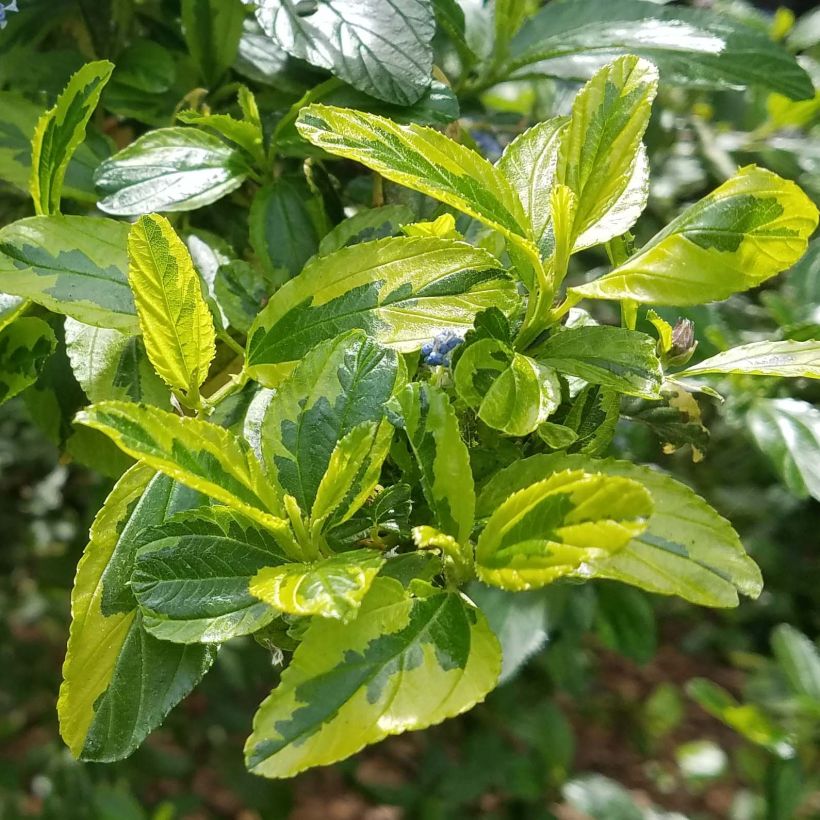

Plant habit
Flowering
Foliage
Botanical data
Ceanothus
thyrsiflorus
El Dorado
Rhamnaceae
California Lilac, Carmel Ceanothus
Cultivar or hybrid
Other Ceanothus
Planting and care
Place Ceanothus in a sunny or partially shaded position in ordinary soil that must be moist in summer, but very well-drained. Beware of cold drafts which the bush does not like. It can be placed near a wall. Plant it throughout the year, except during frost, mixing your garden soil with compost, coarse sand, perlite or any material that does not retain moisture. Water generously once or twice a week to promote growth. Only water twice a month from the third year onwards, and only in case of drought. It is a plant that requires very little maintenance and grows easily as long as the conditions are met. Constant moisture in the soil during the winter period, but also in summer in hot regions, is harmful to the plant. The combination of heat and humidity leads to the development of a fungus that attacks the plant's collar and will be fatal to it. In cooler summer climates Ceanothus appreciate naturally cooler soils in summer. In regions affected by high summer temperatures, it is better to plant Ceanothus on a mound. You can lightly prune the stems after flowering to encourage the plant to branch out. Fertilizer applications are not recommended (just add a little bonemeal at the bottom of the planting hole). Avoid severe pruning.
Pot cultivation:
Use a light substrate, a mixture of garden soil, coarse sand and compost. In summer water abundantly but only when the soil is dry, spacing out waterings. The plant can be stored in a cool and bright space, with little or no heating but protected from severe frost over winter. Apply a slow-release fertilizer in spring and autumn.
Planting period
Intended location
Care
-
, onOrder confirmed
Reply from on Promesse de fleurs
Evergreen shrubs
Haven't found what you were looking for?
Hardiness is the lowest winter temperature a plant can endure without suffering serious damage or even dying. However, hardiness is affected by location (a sheltered area, such as a patio), protection (winter cover) and soil type (hardiness is improved by well-drained soil).

Photo Sharing Terms & Conditions
In order to encourage gardeners to interact and share their experiences, Promesse de fleurs offers various media enabling content to be uploaded onto its Site - in particular via the ‘Photo sharing’ module.
The User agrees to refrain from:
- Posting any content that is illegal, prejudicial, insulting, racist, inciteful to hatred, revisionist, contrary to public decency, that infringes on privacy or on the privacy rights of third parties, in particular the publicity rights of persons and goods, intellectual property rights, or the right to privacy.
- Submitting content on behalf of a third party;
- Impersonate the identity of a third party and/or publish any personal information about a third party;
In general, the User undertakes to refrain from any unethical behaviour.
All Content (in particular text, comments, files, images, photos, videos, creative works, etc.), which may be subject to property or intellectual property rights, image or other private rights, shall remain the property of the User, subject to the limited rights granted by the terms of the licence granted by Promesse de fleurs as stated below. Users are at liberty to publish or not to publish such Content on the Site, notably via the ‘Photo Sharing’ facility, and accept that this Content shall be made public and freely accessible, notably on the Internet.
Users further acknowledge, undertake to have ,and guarantee that they hold all necessary rights and permissions to publish such material on the Site, in particular with regard to the legislation in force pertaining to any privacy, property, intellectual property, image, or contractual rights, or rights of any other nature. By publishing such Content on the Site, Users acknowledge accepting full liability as publishers of the Content within the meaning of the law, and grant Promesse de fleurs, free of charge, an inclusive, worldwide licence for the said Content for the entire duration of its publication, including all reproduction, representation, up/downloading, displaying, performing, transmission, and storage rights.
Users also grant permission for their name to be linked to the Content and accept that this link may not always be made available.
By engaging in posting material, Users consent to their Content becoming automatically accessible on the Internet, in particular on other sites and/or blogs and/or web pages of the Promesse de fleurs site, including in particular social pages and the Promesse de fleurs catalogue.
Users may secure the removal of entrusted content free of charge by issuing a simple request via our contact form.
The flowering period indicated on our website applies to countries and regions located in USDA zone 8 (France, the United Kingdom, Ireland, the Netherlands, etc.)
It will vary according to where you live:
- In zones 9 to 10 (Italy, Spain, Greece, etc.), flowering will occur about 2 to 4 weeks earlier.
- In zones 6 to 7 (Germany, Poland, Slovenia, and lower mountainous regions), flowering will be delayed by 2 to 3 weeks.
- In zone 5 (Central Europe, Scandinavia), blooming will be delayed by 3 to 5 weeks.
In temperate climates, pruning of spring-flowering shrubs (forsythia, spireas, etc.) should be done just after flowering.
Pruning of summer-flowering shrubs (Indian Lilac, Perovskia, etc.) can be done in winter or spring.
In cold regions as well as with frost-sensitive plants, avoid pruning too early when severe frosts may still occur.
The planting period indicated on our website applies to countries and regions located in USDA zone 8 (France, United Kingdom, Ireland, Netherlands).
It will vary according to where you live:
- In Mediterranean zones (Marseille, Madrid, Milan, etc.), autumn and winter are the best planting periods.
- In continental zones (Strasbourg, Munich, Vienna, etc.), delay planting by 2 to 3 weeks in spring and bring it forward by 2 to 4 weeks in autumn.
- In mountainous regions (the Alps, Pyrenees, Carpathians, etc.), it is best to plant in late spring (May-June) or late summer (August-September).
The harvesting period indicated on our website applies to countries and regions in USDA zone 8 (France, England, Ireland, the Netherlands).
In colder areas (Scandinavia, Poland, Austria...) fruit and vegetable harvests are likely to be delayed by 3-4 weeks.
In warmer areas (Italy, Spain, Greece, etc.), harvesting will probably take place earlier, depending on weather conditions.
The sowing periods indicated on our website apply to countries and regions within USDA Zone 8 (France, UK, Ireland, Netherlands).
In colder areas (Scandinavia, Poland, Austria...), delay any outdoor sowing by 3-4 weeks, or sow under glass.
In warmer climes (Italy, Spain, Greece, etc.), bring outdoor sowing forward by a few weeks.



































